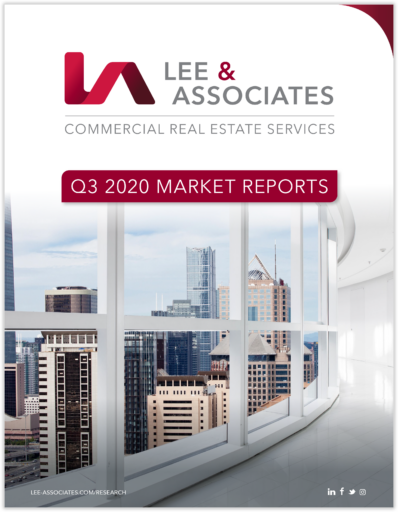INDUSTRIAL OVERVIEW:
A sharp increase in online shopping that was brought on by the pandemic has heightened third-quarter demand for industrial space. But net absorption year to date, 104.5 million SF, is 23.2% less than a year ago and the least growth through the first three quarters since 2012. Third-quarter net absorption totaled 51.9 million. The overall vacancy rate for the quarter settled at 5.7%, a 20-basis point increase this year. There were approximately 67 million SF delivered in Q3. Most of the record 331 million SF under construction is spec logistics product. Some 200 million SF is slated for delivery over the next two quarters, a high-water mark in the current cycle. Nevertheless, industrial property should continue to outperform other commercial real estate categories. There’s also speculation that much of the sudden growth in e-commerce may be sustained after the pandemic ends.
After declining for the first two quarters, the nation’s seaports reported upswings in container traffic. For example, after reporting a 12% reduction in cargo during the first half of the year, the twin ports of Los Angeles and Long Beach posted record-breaking container handling in July and August. Port officials attributed the surge to pent-up demand for imported consumer goods. Moderating leasing activity has cooled year-over-year rent growth to 2.3%. That was a decline from 3.8% for the 12 months ending with Q2 and snapped a six-year string of 5% annual gains. Declines could continue. READ MORE >
OFFICE OVERVIEW:
The nation’s office market was socked by the pandemic in the third quarter as companies shed 33.6 million net SF of space nationwide. Year-to-date negative net absorption hit 55 million SF, more than erasing last year’s 44.3 million SF of net growth. The contraction pushed the vacancy rate of the nearly 8.1-billion-SF national inventory up 50 basis points from Q2, settling at 10.8%.
Meanwhile, in the next two quarters – as most of the nation still may be anticipating vaccine approval and distribution – about 53 million SF of space is set to emerge from the construction pipeline now at 155.7 million SF. Tech hubs such as Austin, San Jose, and San Francisco are seeing most of the new construction.
There has been a dramatic rise in available sublease space now at 144 million SF with 60 million SF added since March. Leasing activity in August was 50% less than at the start of the year. Since July, fewer than 150 leases have been signed for blocks of space larger than 10,000 SF.
As companies reassess office space needs, employees are in no hurry to return. Many workers are anxious about becoming infected by less vigilant people on buses, subway cars and elevator cabs. Many major markets are reporting office occupancy as low as 10% to 15%. READ MORE >
RETAIL OVERVIEW:
Already losing ground to e-commerce before the pandemic hit, the retail sector’s woes are mounting. Tenants shed 14 million SF of space nationwide in the third quarter, nearly equaling 2Q’s dismal performance and increasing the negative net absorption total this year to 37.7 million SF. It is the largest recorded year-to-date contraction and greatest year-over-year retreat since growth slowed from 135.8 million SF in 2008 to 7.7 million SF in 2009.
Year-to-date rent growth slipped to 0.1% in Q3 compared to 2.6% over the same period last year. The rising vacancy rate settled at 4.8% in Q3 after reaching the cyclical bottom of 4.4% in 2018 and posting nine years of growth.
Little reason for optimism can be found in the near-term outlook. Recovery for brick-and-mortar retail and the broader economy can’t begin to occur without widespread coronavirus vaccinations, which could be well into 2021, and additional government relief. That leaves aside spiking infection rates across the nation early in Q4, causing top health officials to intensify their warnings of a second wave. Long term, there’s anxiousness whether merchants will regain their share of lost trade after the pandemic as online purchasing of consumer goods has become routine for more shoppers. READ MORE >
MULTIFAMILY OVERVIEW:
The Covid recession continues to heavily impact the multifamily sector. The Q3 vacancy rate reached 6.8%, the highest since 2011. Moreover, the 17.2-million-unit sector is in a period of heavy additions of new supply, raising the specter of 8% vacancy.
The latest survey of apartment buildings by the National Multi-Housing Council shows 86.8% of 11.5-million tenants made full or partial monthly rent payments in October, a 2.4% decrease from the same period last year. NMHC’s President Doug Bibby joined a chorus calling for more federal relief. “Perceived quick fixes like eviction moratoriums do nothing to solve the underlying economic problems residents are facing and could jeopardize the stability of the housing market and the financial health of our communities. Congress and the administration must act to avert a future housing crisis,” Bibby said.
Year-over-year rent growth nationally has fallen to 0.3% after gaining 2.6% last year and rents have fallen about 1% since March. The pandemic also has led to a sharp slowdown in sales transactions, and for-sale listings have fallen to roughly half of normal. READ MORE >




